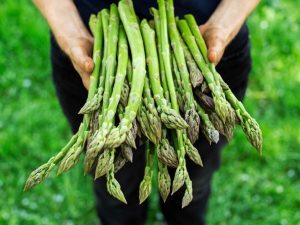Prebiotics are a type of fibre (but not all fibre is a prebiotic). This type of fibre passes through the gut undigested.
Put simply, prebiotics are fuel for healthy gut bacteria, so it’s important to eat enough prebiotics to keep the populations alive and healthy.
Prebiotics occur naturally in all vegetables but some have particularly high levels.
These include:
- garlic, onions, leeks, shallots and spring onions
- asparagus, savoy cabbage, Jerusalem artichokes and beetroot
- green peas, snow peas and sweetcorn.
Prebiotics also occur in legumes such as chickpeas, lentils and red kidney beans.
Recipe: White Cannellini (or Red Kidney) Beans, Zucchini, Hemp Seeds, Turmeric, and Thyme patties
Brown rice
Brown rice is also a prebiotic. The nutrients in this healthy wholegrain help to feed healthy gut bacteria. So to get the benefits, opt for brown rice over white rice wherever possible.
Red and black rice are also good options for the gut. And, luckily, they are becoming more available in some supermarkets.
Oats
Oats contain a unique type of fibre that nourishes and restores healthy gut bacteria. It’s important to go for whole, rolled or steel cut oats, rather than quick oats. This is because whole oats include the outer layer of the grain, which is where all the good nutrients and fibre are found.
Oats are a cheap and easy food to eat regularly and they are especially suited to breakfast – in porridge and muesli, or add them to a smoothie to help thicken it.
Linseeds
These tiny brown or golden-coloured seeds are high in fibre and healthy fats. Also known as ‘flaxseeds’, linseeds help to create a healthy environment in the gut where good bacteria want to grow and live.
Ms Villella recommends freshly grinding linseeds at home in a coffee grinder or spice grinder. Ground seeds can then be stored for up to two weeks in an airtight container in the fridge.
You can still eat whole (unground) linseeds, but you won’t absorb as much of the fibre.
You can also buy pre-ground linseeds, but you might miss out on the healthy fats. After being ground the healthy fats start breaking down (oxidising). So fresh is best!
Get more linseeds into your daily diet by adding to recipes, or simply sprinkle a tablespoon or two of ground seeds over your porridge or muesli in the morning.
Yoghurt and kefir
Another way to support your populations of healthy bacteria is by eating them. Yoghurts often contain healthy gut bacteria, but it’s important to check the labels. Some products list the type and quantity of good bacteria. Try to eat a yoghurt that contains around one billion good bacteria per serve.
Kefir is a fermented milk drink and is a bit like thin yoghurt. Kefir often contains even greater amounts of healthy bacteria than yoghurt. It’s available to buy in major supermarkets and health food stores, or some people make it at home. It can be quite sour to taste, but many people enjoy it as part of their breakfast – added to smoothies or with fruit.
